Influence of the Direction of Mixture Compaction on the Selected Properties of a Hemp-Lime Composite
Abstract
:1. Introduction
2. Materials and Methods
2.1. Materials and Recipes
2.2. Preparation of the Specimens
2.3. Capillary Uptake
2.4. Thermal Conductivity
2.5. Flexural and Compressive Strengths
2.6. Thermal Analysis
- model definition (materials, geometry, and boundary conditions),
- mesh generation,
- use of Finite Element Analysis Solver for determining the temperature in nodes and heat streams,
- post-processing and reporting the obtained analytical results (e.g., average heat transfer coefficient for a given node) and the processed results in a graphical form (e.g., isotherms).
Analyzed Partitions
3. Results and Discussion
3.1. General Characteristics of Composites
3.2. Capillary Uptake
3.3. Thermal Conductivity
3.4. Flexural and Compressive Strengths
3.5. Thermal Analysis
4. Conclusions
- The direction of heat flow in relation to the direction of compaction of the hemp-lime mixture in the formwork affects the thermal conductivity of the composite. The difference in the lambda value in the case of THS is about 16%, while in the case of the composites with fine shives (FHS), it is about 12%. The value of the thermal conductivity coefficient is lower in the case of the heat flow in the direction parallel to compaction.
- The direction of compaction of the mixture influences the course of the capillary uptake of water by the composite. A smaller amount of water pulled up by capillary action occurred in the case of the samples compacted in the direction parallel to water uptake. The difference in the water absorption coefficient in the case of THS is about 18.4%, while in the case of the composites with fine shives (FHS), it is about 17.6%. The composites containing longer and thicker shives (THS) showed a greater tendency towards the water uptake by capillary action.
- The direction in which the compressive force is applied has a significant impact on the strength of the composite and its behavior under increasing load. Loading the samples in the direction of mixing the mixture results in greater deformability with a slower increase in stress. On the other hand, the samples loaded in the direction perpendicular to compaction are stiffer. The destruction in this case is more pronounced and occurs with less deformation. The material behavior when the force direction is changed is more varied in the case of the THS composite.
- The direction of bending of composite samples in relation to compaction of the mixture influences its flexural strength and deformability under loading. Both composites (THS and FHS) showed greater stiffness and flexural strength, being loaded perpendicular to the direction of mixture compaction. The difference in the flexural strength in the case of THS is about 29%, while in the case of the composites with fine shives (FHS), it is about 73%. The composites containing longer and thicker shives (THS) are characterized by greater strength, and—at the same time—greater capacity for deformation.
- The thermal simulation of the partition showed that the timber studs create the linear thermal bridges in the wall insulated with a hemp-lime composite. The linear thermal transmittance coefficient decreases together with the increasing layer thickness of each of the tested composites. In a wall insulated with a composite having the lowest thermal conductivity (THS ⊥), the value of this coefficient is the highest. By compacting the mixture parallel to the direction of heat flow, it is possible to reduce the thickness of the hemp-lime insulation layer by 30 mm in order to meet the Polish thermal requirements (U < 0.2 W/m2 K), compared to composites compacted in the direction perpendicular to the heat flow.
Author Contributions
Funding
Data Availability Statement
Acknowledgments
Conflicts of Interest
References
- Williams, J.; Lawrence, M.; Walker, P. The Influence of the Casting Process on the Internal Structure and Physical Properties of Hemp-Lime. Mater. Struct. 2016, 50, 108. [Google Scholar] [CrossRef] [Green Version]
- Suchorab, Z.; Brzyski, P.; Raczkowski, A.; Garbacz, M.; Życzyńska, A. Laboratory Determination of Hygric and Thermal Anisotropy of Aerated Concrete. In Proceedings of the AIP Conference Proceedings, Maharashtra, India, 5–6 July 2018; Volume 1988, p. 020045. [Google Scholar] [CrossRef]
- Malaga-Toboła, U.; Łapka, M.; Tabor, S.; Niesłony, A.; Findura, P. Influence of Wood Anisotropy on Its Mechanical Properties in Relation to the Scale Effect. Int. Agrophys. 2019, 33, 337–345. [Google Scholar] [CrossRef]
- Cabrillac, R.; Fiorio, B.; Beaucour, A.L.; Dumontet, H.; Ortola, S. Experimental Study of the Mechanical Anisotropy of Aerated Concretes and of the Adjustment Parameters of the Introduced Porosity. Constr. Build. Mater. 2006, 20, 286–295. [Google Scholar] [CrossRef]
- Brzyski, P.; Suchorab, Z.; Malec-Marczewska, A. Laboratory Determination of Hygric and Thermal Anisotropy of Hemp-Lime Composite. In Proceedings of the AIP Conference Proceedings, Tangerang Selatan, Indonesia, 19–20 November 2020; Volume 2275, p. 020003. [Google Scholar] [CrossRef]
- Fort, R.; Varas, M.J.; Alvarez de Buergo, M.; Martin-Freire, D. Determination of Anisotropy to Enhance the Durability of Natural Stone. J. Geophys. Eng. 2011, 8, S132–S144. [Google Scholar] [CrossRef]
- Kretschmann, D. Velcro Mechanics in Wood. Nat. Mater. 2003, 2, 775–776. [Google Scholar] [CrossRef]
- Cordin, M.; Bechtold, T.; Pham, T. Effect of Fibre Orientation on the Mechanical Properties of Polypropylene—Lyocell Composites. Cellulose 2018, 25, 7197–7210. [Google Scholar] [CrossRef] [Green Version]
- Madhuri, K.S.; Rao, H.R.; Reddy, B.C.M. Effect of Fiber Orientation and Loading on the Tensile Properties of Hardwickia Binata Fiber Reinforced Epoxy Composites. Int. J. Pure Appl. Math. 2017, 117, 57–61. [Google Scholar] [CrossRef]
- Jackson, P.W.; Cratchley, D. The Effect of Fibre Orientation on the Tensile Strength of Fibre-Reinforced Metals. J. Mech. Phys. Solids 1966, 14, 49–64. [Google Scholar] [CrossRef]
- Hossain, M.R.; Islam, M.A.; Vuurea, A.V.; Verpoest, I. Effect of fiber orientation on the tensile properties of jute epoxy laminated composite. J. Sci. Res. 2013, 5, 43–54. [Google Scholar] [CrossRef]
- Stevulova, N.; Kidalova, L.; Junak, J.; Cigasova, J.; Terpakova, E. Effect of Hemp Shive Sizes on Mechanical Properties of Lightweight Fibrous Composites. Procedia Eng. 2012, 42, 496–500. [Google Scholar] [CrossRef] [Green Version]
- Stevulova, N.; Kidalova, L.; Cigasova, J.; Junak, J.; Sicakova, A.; Terpakova, E. Lightweight Composites Containing Hemp Hurds. Procedia Eng. 2013, 65, 69–74. [Google Scholar] [CrossRef] [Green Version]
- Bourdot, A.; Moussa, T.; Gacoin, A.; Maalouf, C.; Vazquez, P.; Thomachot-Schneider, C.; Bliard, C.; Merabtine, A.; Lachi, M.; Douzane, O.; et al. Laboratory Characterization of a hemp-based agro-material: Influence of starch ratio and hemp shive size on physical, mechanical, and hygrothermal properties. Energy Build. 2017, 153, 501–512. [Google Scholar] [CrossRef]
- Balčiūnas, G.; Vėjelis, S.; Vaitkus, S.; Kairytė, A. Physical Properties and Structure of Composite Made by Using Hemp Hurds and Different Binding Materials. Procedia Eng. 2013, 57, 159–166. [Google Scholar] [CrossRef] [Green Version]
- Brzyski, P.; Gładecki, M.; Rumińska, M.; Pietrak, K.; Kubiś, M.; Łapka, P. Influence of Hemp Shives Size on Hygro-Thermal and Mechanical Properties of a Hemp-Lime Composite. Materials 2020, 13, 5383. [Google Scholar] [CrossRef] [PubMed]
- Nguyen, T.; Picandet, V.; Carre, P.; Lecompte, T.; Amziane, S.; Baley, C. Effect of Compaction on Mechanical and Thermal Properties of Hemp Concrete. Eur. J. Environ. Civ. Eng. 2010, 14, 545–560. [Google Scholar] [CrossRef]
- Pierre, T.; Colinart, T.; Glouannec, P. Measurement of Thermal Properties of Biosourced Building Materials. Int. J. Thermophys. 2014, 35, 1832–1852. [Google Scholar] [CrossRef]
- Nozahic, V.; Amziane, S.; Torrent, G.; Saïdi, K.; De Baynast, H. Design of Green Concrete Made of Plant-Derived Aggregates and a Pumice-Lime Binder. Cem. Concr. Compos. 2012, 34. [Google Scholar] [CrossRef]
- Williams, J.; Lawrence, M.; Walker, P. The influence of constituents on the properties of the bio-aggregate composite hemp-lime. Constr. Build. Mater. 2018, 159, 9–17. [Google Scholar] [CrossRef]
- Cabrillac, R.; Billoet, J.L.; Ami-Saada, R. Influence de la porosité et de sa configuration sur le comportement mécanique et thermique des matériaux poreux anisotropes. Cahi. Rhéol.(Paris) 1992, 10, 19–31. [Google Scholar]
- Cabrillac, R.; Malou, Z.; Dumontet, H. Study of the influence of shape and orientation of the pores on the rigidity of porous materials through a homogenization method. In Proceedings of the Sixth International Conference Computers in Composite Materials CADCOMP 98, Montreal, QC, Canada, 26–28 August 1998. [Google Scholar]
- Minke, G.; Mahlke, F. Building with Straw: Design and Technology of a Sustainable Architecture; Birkhäuser Architecture: Basel, Switzerland, 2005. [Google Scholar]
- Keppert, M.; Urbanová, M.; Brus, J.; Čáchová, M.; Fořt, J.; Trník, A.; Scheinherrová, L.; Záleská, M.; Černý, R. Rational Design of Cement Composites Containing Pozzolanic Additions. Constr. Build. Mater. 2017, 148, 411–418. [Google Scholar] [CrossRef]
- Toutanji, H.A.; TaharEl-Korchi, T. The influence of silica fume on the compressive strength of cement paste and mortar. Cem. Concr. Res. 1995, 25, 1591–1602. [Google Scholar] [CrossRef]
- Gameiroa, A.; Santos Silva, A.; Faria, P.; Grilo, J.; Branco, T.; Veiga, R.; Velosa, A. Physical and chemical assessment of lime-metakaolin mortars: Influence of binder:aggregate ratio. Cem. Concr. Compos. 2014, 45, 264–271. [Google Scholar] [CrossRef] [Green Version]
- Walker, R.; Pavía, S. Moisture Transfer and Thermal Properties of Hemp-Lime Concretes. Constr. Build. Mater. 2014, 64, 270–276. [Google Scholar] [CrossRef]
- Walker, R.; Pavia, S.; Mitchell, R. Mechanical Properties and Durability of Hemp-Lime Concretes. Constr. Build. Mater. 2014, 61, 340–348. [Google Scholar] [CrossRef]
- Brzyski, P.; Suchorab, Z. Capillary Uptake Monitoring in Lime-Hemp-Perlite Composite Using the Time Domain Reflectometry Sensing Technique for Moisture Detection in Building Composites. Materials 2020, 13, 1677. [Google Scholar] [CrossRef] [PubMed] [Green Version]
- Polish Committee for Standardization. Natural stone test methods. In Determination of Water Absorption Coefficient by Capillarity; PN-EN 1925:1999; Polish Committee for Standardization: Warsaw, Poland, 1999. [Google Scholar]
- European Committee for Standardization. Thermal Insulation—Determination of Steady-State Thermal Resistance and Related Properties—Guarded Hot Plate Apparatus; ISO 8302:1991; European Committee for Standardization: Geneva, Switzerland, 1991. [Google Scholar]
- Windows & Daylightning, Building Technology & Urban Systems. Available online: https://windows.lbl.gov/ (accessed on 23 July 2021).
- Real, S.; Gomes, M.G.; Moret Rodrigues, A.; Bogas, J.A. Contribution of Structural Lightweight Aggregate Concrete to the Reduction of Thermal Bridging Effect in Buildings. Constr. Build. Mater. 2016, 121, 460–470. [Google Scholar] [CrossRef]
- Murad, C.; Doshi, H.; Ramakrishnan, R. Impact of Insulated Concrete Curb on Concrete Balcony Slab. Procedia Eng. 2015, 118, 1030–1037. [Google Scholar] [CrossRef] [Green Version]
- Stazi, F.; Tomassoni, E.; Bonfigli, C.; Di Perna, C. Energy, comfort and environmental assessment of different building envelope techniques in a Mediterranean climate with a hot dry summer. Appl. Energy 2014, 134, 176–196. [Google Scholar] [CrossRef]
- Grudzińska, M.; Brzyski, P. The Occurrence of Thermal Bridges in Hemp-Lime Construction Junctions. Period. Polytech. Civ. Eng. 2019, 63, 377–387. [Google Scholar] [CrossRef]
- Mitchell, R.; Kohler, C.; Zhu, L.; Arasteh, D.; Carmody, J.; Huizenga, C.; Curcija, D. Therm 6.3/Window 6.3 NFRC Simulation Manual; Lawrence Berkeley National Laboratory: Berkeley, CA, USA, 2011.
- European Committee for Standardization. Thermal Bridges in Building Construction. Heat Flows and Surface Temperatures. Detailed Calculations; ISO 10211:2017; European Committee for Standardization: Geneva, Switzerland, 2017. [Google Scholar]
- European Committee for Standardization. Building Components and Building Elements. Thermal Resistance and Thermal Transmittance. Calculation Methods; European Committee for Standardization: Geneva, Switzerland, 2017. [Google Scholar]
- Tierrafino. Available online: http://www.tierrafino.com/ (accessed on 23 July 2021).
- European Committee for Standardization. Building Materials and Products. Hygrothermal Properties. Tabulated Design Values and Procedures for Determining Declared and Design Thermal Values; ISO 10456:2007; European Committee for Standardization: Geneva, Switzerland, 2007. [Google Scholar]
- STEICO Engineered by Nature. Available online: https://web.steico.com/en/ (accessed on 23 July 2021).
- Amziane, S.; Nozahic, V.; Sonebi, M. Design of Mechanically Enhanced Concrete Using Hemp Shiv. Acad. J. Civ. Eng. 2015, 33, 422–426. [Google Scholar] [CrossRef]
- Dinh, T.M.; Magniont, C.; Coutand, M.; Escadeillas, G. Hemp Concrete Using Innovative Pozzolanic Binder. Acad. J. Civ. Eng. 2015, 33, 265–270. [Google Scholar]
- Elfordy, S.; Lucas, F.; Tancret, F.; Scudeller, Y.; Goudet, L. Mechanical and Thermal Properties of Lime and Hemp Concrete (“Hempcrete”) Manufactured by a Projection Process. Constr. Build. Mater. 2008, 22, 2116–2123. [Google Scholar] [CrossRef]
- Bevan, R.; Wooley, T. Hemp Lime Construction—A Guide to Building with Hemp Lime Composites; IHS BRE: Bracknell, UK, 2008. [Google Scholar]
- Zardari, M.A.; Lakho, N.A. Effect of Compaction during Casting on Anisotropic Compressive Strength of Baked Clay. Teh. Vjesn. 2018, 25, 1667–1671. [Google Scholar] [CrossRef]
- Rozporządzenie Ministra Infrastruktury w Sprawie Warunków Technicznych, Jakim Powinny Odpowiadać Budynki i ich Usytuowanie. Available online: http://isap.sejm.gov.pl/ (accessed on 23 July 2021). (In Polish)
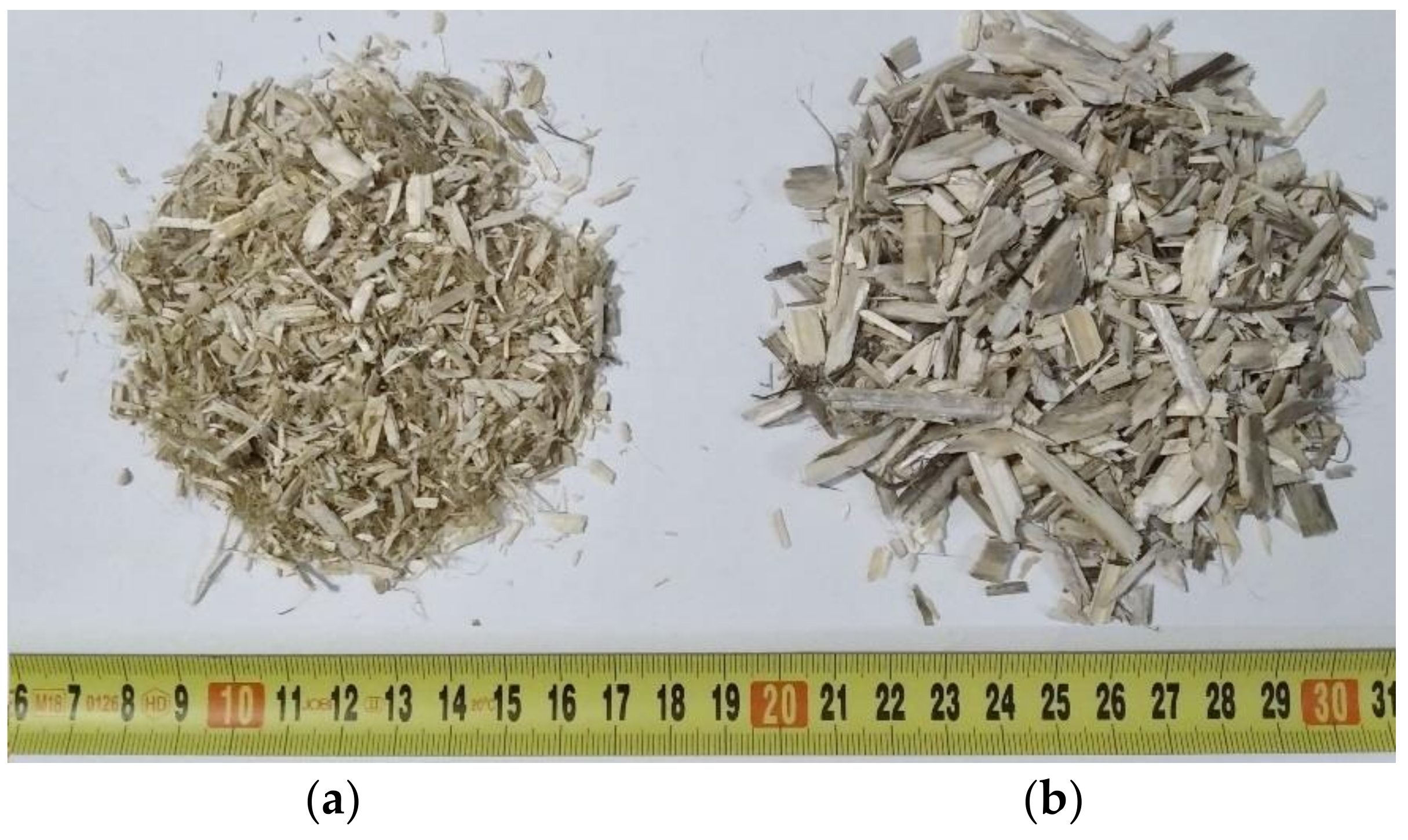

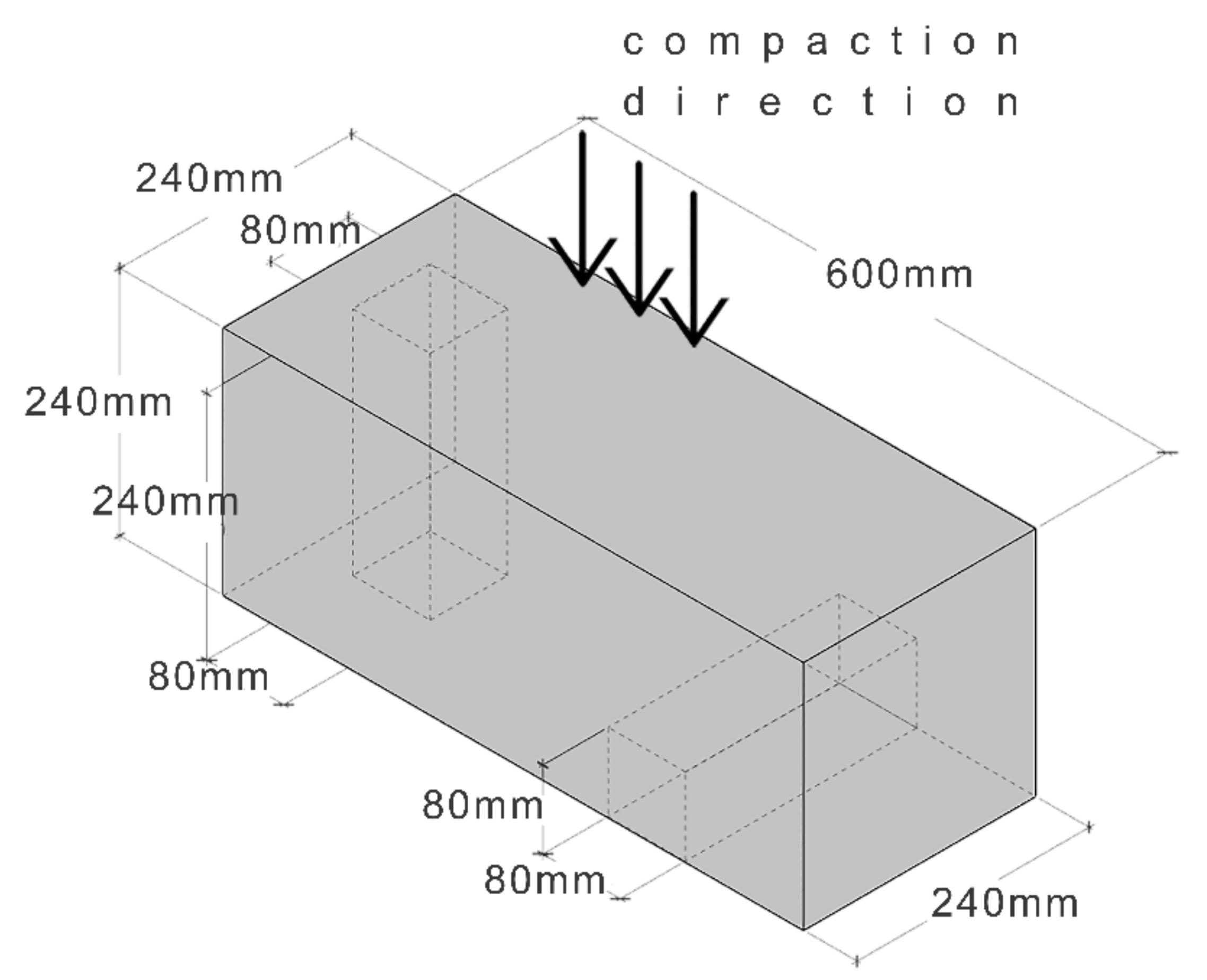
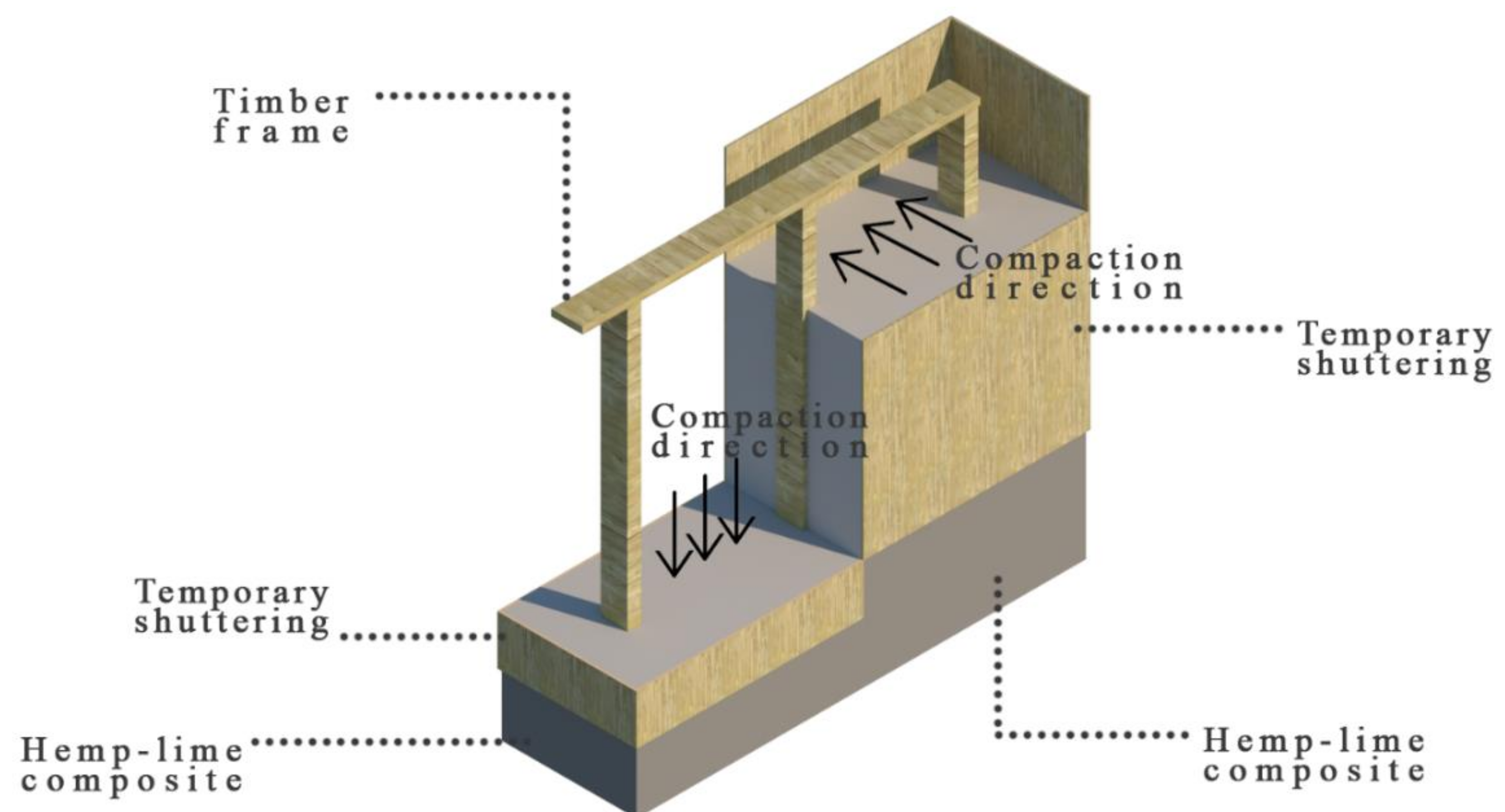

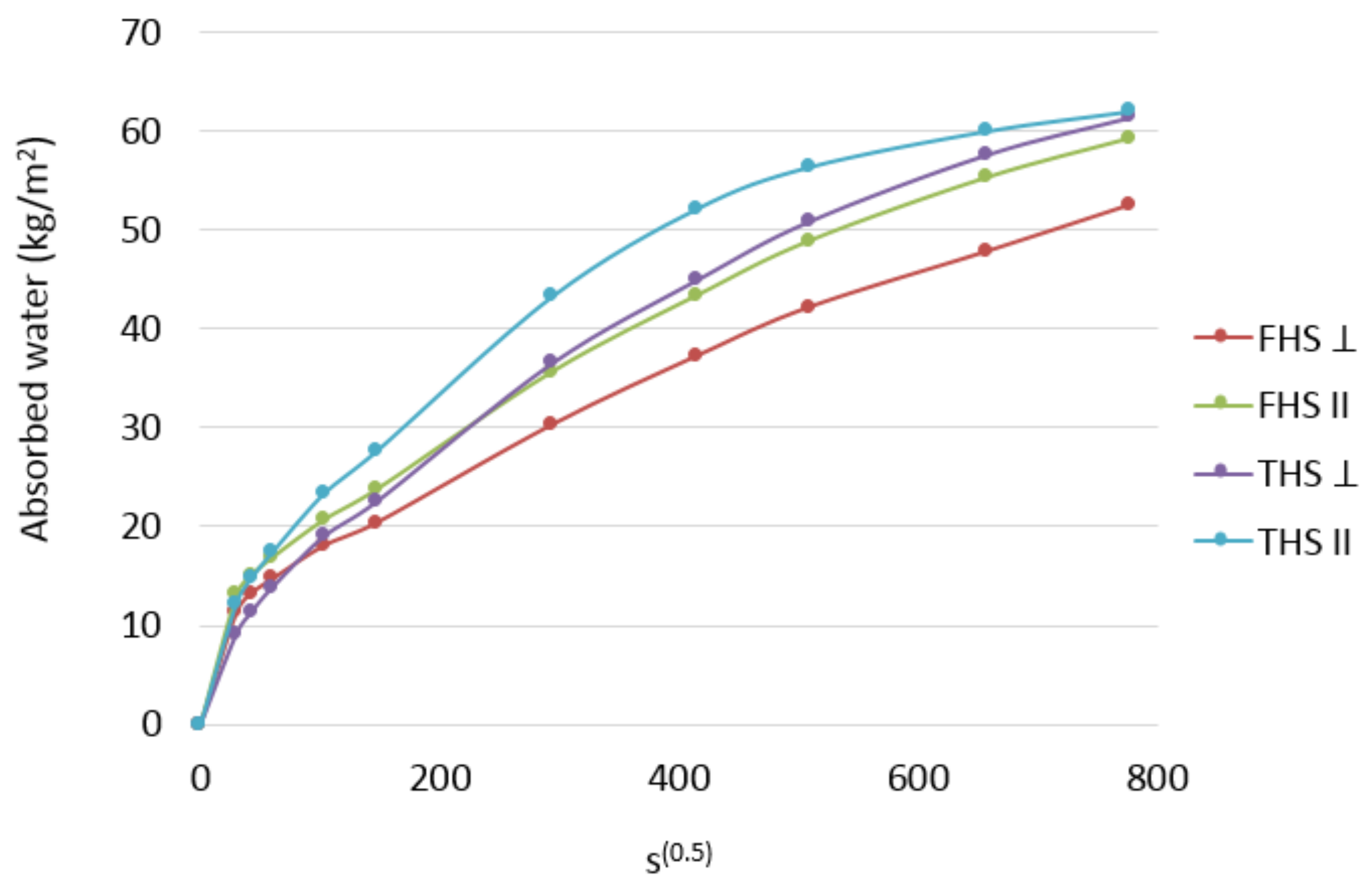

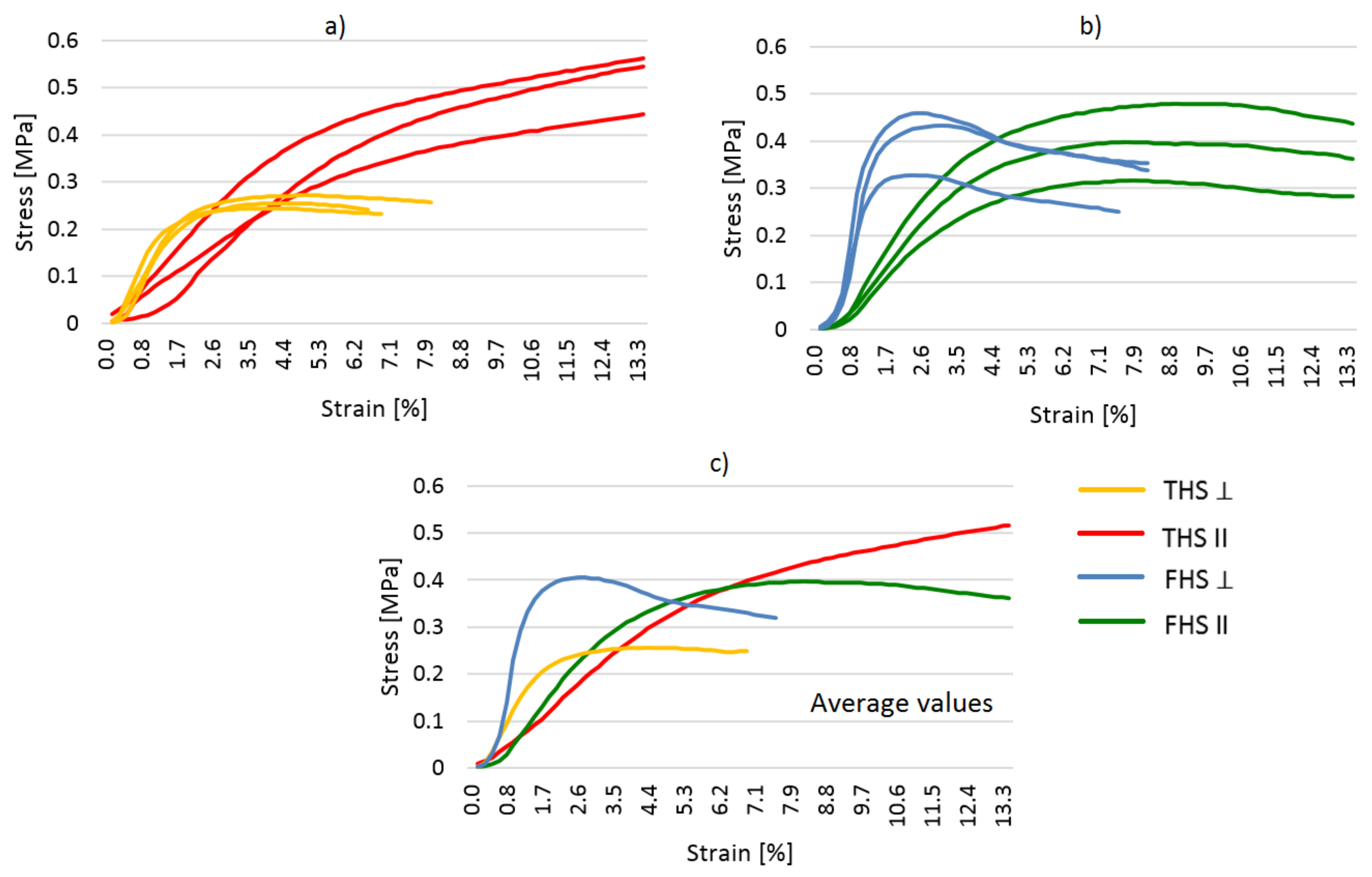
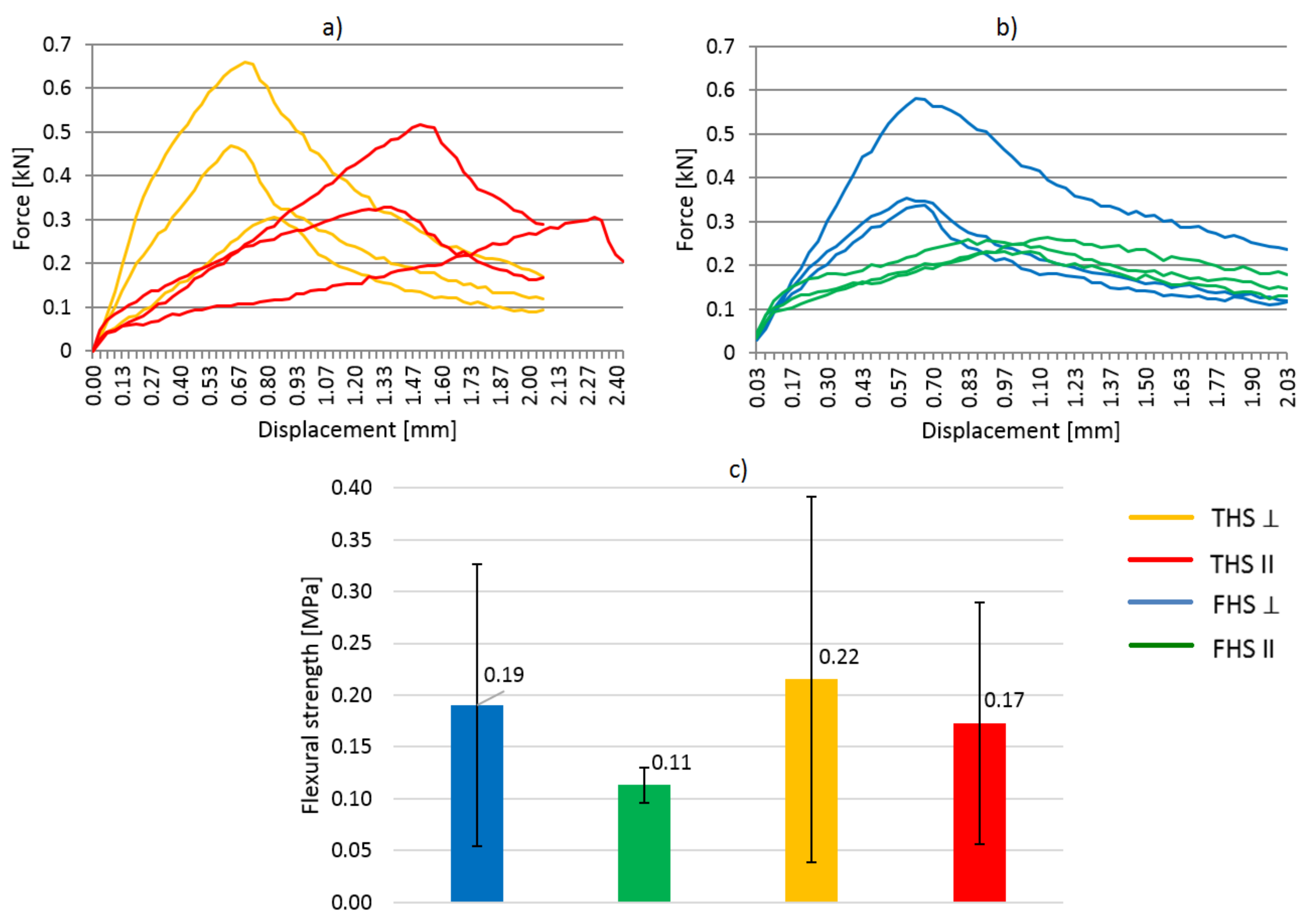

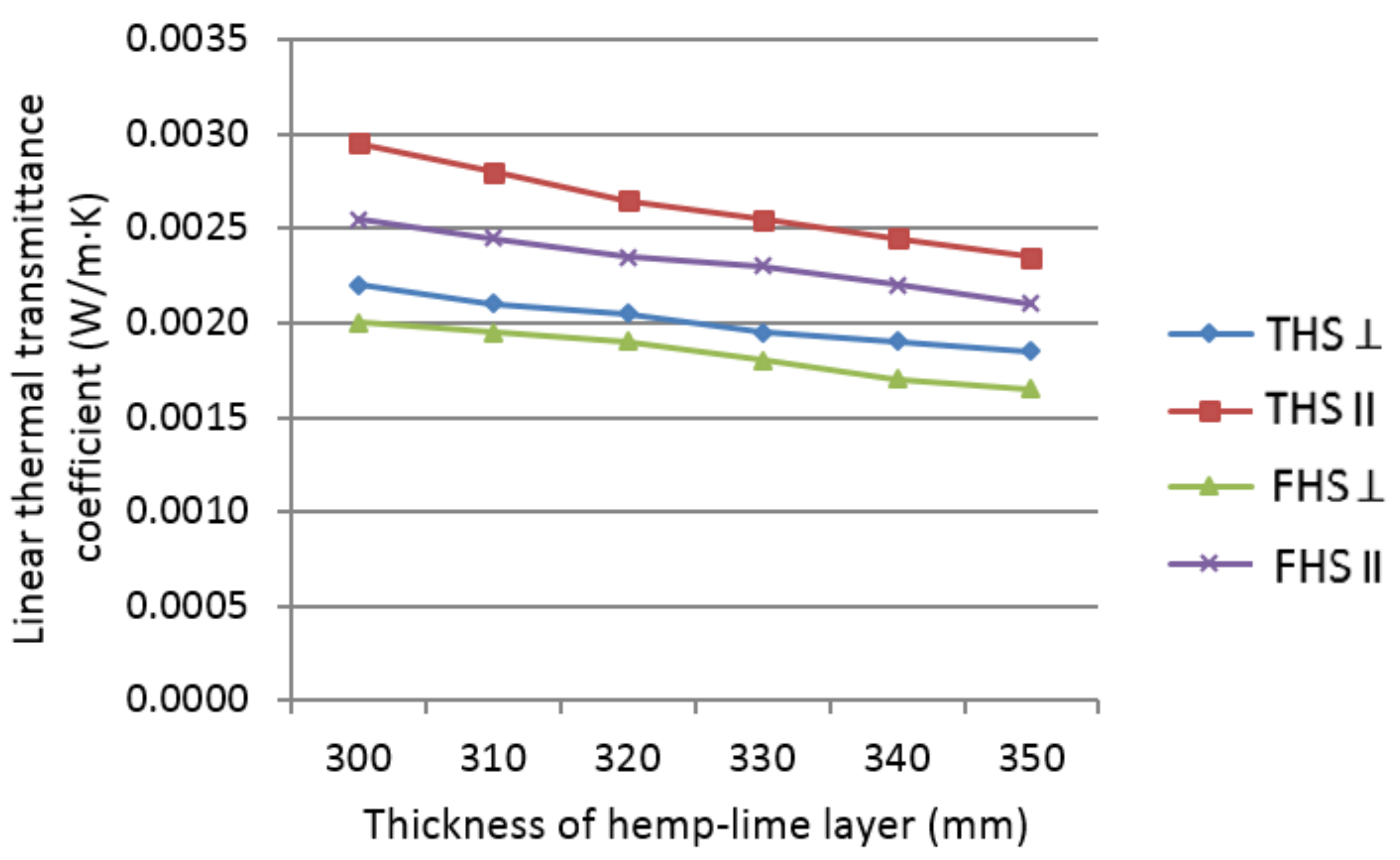
| Components | THS | FHS |
|---|---|---|
| Hydrated lime | 205.8 | 213.4 |
| Metakaolinite | 51.4 | 53.4 |
| Fine hemp shives | - | 133.4 |
| Thick hemp shives | 128.6 | - |
| Methylcellulose | 1.28 | 1.33 |
| Water | 442.4 | 434.9 |
| Composite Symbol | Description |
|---|---|
| FHS II | Composite containing fine shives, samples tested parallel to the compaction direction |
| THS II | Composite containing thick shives, samples tested parallel to the compaction direction |
| FHS ⊥ | Composite containing fine shives, samples tested perpendicular to the compaction direction |
| THS ⊥ | Composite containing thick shives, samples tested perpendicular to the compaction direction |
| Building Material/Element | Thermal Conductivity [W/(m∙K)] |
|---|---|
| Hemp-lime composite | 0.087/0.094/0.101/0.105 |
| Clay plaster | 0.91 |
| Lime render | 0.80 |
| Hemp wool | 0.046 |
| Timber construction element | 0.16 |
| Surface | Temperature [°C] | Surface Resistance [(m2·K)/W] | Description |
|---|---|---|---|
| Internal | +20 | 0.13 | Heat flow horizontal, simplified * |
| External | −2.6 | 0.04 | Simplified * |
| Cut-off planes | ‒ | ‒ | Adiabatic |
| Parameter (Unit) | FHS | THS |
|---|---|---|
| Apparent density (kg/m3) | 382.4 | 376.9 |
| Total porosity (%) | 82.2 | 81.7 |
| Mass water absorptivity (after 7 days) (%) | 126.9 | 115.5 |
| Specific heat (J/(kg∙K)) | 1575 | 1601 |
| Water vapor diffusion resistance factor (-) | 4.94 | 5.57 |
Publisher’s Note: MDPI stays neutral with regard to jurisdictional claims in published maps and institutional affiliations. |
© 2021 by the authors. Licensee MDPI, Basel, Switzerland. This article is an open access article distributed under the terms and conditions of the Creative Commons Attribution (CC BY) license (https://creativecommons.org/licenses/by/4.0/).
Share and Cite
Brzyski, P.; Gleń, P.; Gładecki, M.; Rumińska, M.; Suchorab, Z.; Łagód, G. Influence of the Direction of Mixture Compaction on the Selected Properties of a Hemp-Lime Composite. Materials 2021, 14, 4629. https://doi.org/10.3390/ma14164629
Brzyski P, Gleń P, Gładecki M, Rumińska M, Suchorab Z, Łagód G. Influence of the Direction of Mixture Compaction on the Selected Properties of a Hemp-Lime Composite. Materials. 2021; 14(16):4629. https://doi.org/10.3390/ma14164629
Chicago/Turabian StyleBrzyski, Przemysław, Piotr Gleń, Mateusz Gładecki, Monika Rumińska, Zbigniew Suchorab, and Grzegorz Łagód. 2021. "Influence of the Direction of Mixture Compaction on the Selected Properties of a Hemp-Lime Composite" Materials 14, no. 16: 4629. https://doi.org/10.3390/ma14164629
APA StyleBrzyski, P., Gleń, P., Gładecki, M., Rumińska, M., Suchorab, Z., & Łagód, G. (2021). Influence of the Direction of Mixture Compaction on the Selected Properties of a Hemp-Lime Composite. Materials, 14(16), 4629. https://doi.org/10.3390/ma14164629









